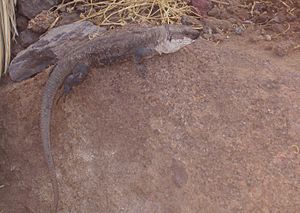La Gomera giant lizard facts for kids
Quick facts for kids La Gomera giant lizard |
|
|---|---|
 |
|
| Conservation status | |
| Scientific classification | |
| Genus: |
Gallotia
|
| Species: |
bravoana
|
| Synonyms | |
|
|
The La Gomera giant lizard (scientific name: Gallotia bravoana) is a special type of wall lizard. It lives only on the island of La Gomera, which is one of the Canary Islands near Africa.
This lizard is easy to spot because of its unique look! It has a bright white neck, chest, and mouth area. This white color stands out against its dark brown back. These lizards are active during the day and mostly eat plants. They can grow to be about half a meter long, including their head and body. Female lizards usually lay one group of eggs each year, with about three to seven eggs. Good news! The number of these lizards has been slowly growing since 2001.
Contents
A Lizard's Life: Discovery and Survival
For a long time, people thought the La Gomera giant lizard was gone forever. Reports from La Gomera mentioned these lizards up until the 1800s, but then they seemed to disappear. Scientists first described this species in 1985 using old subfossil bones. They thought it had already become extinct.
But then, something amazing happened! In 1999, a team of Spanish biologists, led by Juan Carlos Rando, found this lizard alive again! It was like finding a lost treasure. They only found six living lizards, which was a very small number.
Where They Live Now
In 2004, there were only about 90 La Gomera giant lizards living in the wild. Luckily, about 44 more were being cared for in special breeding programs. Today, these lizards are only found in two hard-to-reach places. These are cliffs about 2 kilometers apart, near a place called Valle Gran Rey.
Scientists believe that the La Gomera giant lizard once lived all over La Gomera in many different types of places. Now, their home is much smaller. They live in the Parque Rural de Valle Gran Rey, on dry cliffs with not many plants. Their current home is less than one hectare (which is about the size of a soccer field).
Protecting the La Gomera Giant Lizard
The La Gomera giant lizard is listed as Critically Endangered by the IUCN Red List. This means it is at a very high risk of becoming extinct in the wild.
In the past, the number of these lizards went down because of too much overgrazing by animals, hunting, and attacks from wild cats and rats. Today, the biggest dangers are still attacks from wild cats and falling rocks in their small living areas.
Good news again! This lizard is protected by international laws. There's also a special plan to help the species recover. On La Gomera, a program has been set up to breed these lizards in captivity. This helps increase their numbers. To make sure the lizards in the wild survive and can be released back into new areas, people need to control the number of wild cats around where the lizards live.
See also
 In Spanish: Lagarto gigante de La Gomera para niños
In Spanish: Lagarto gigante de La Gomera para niños


